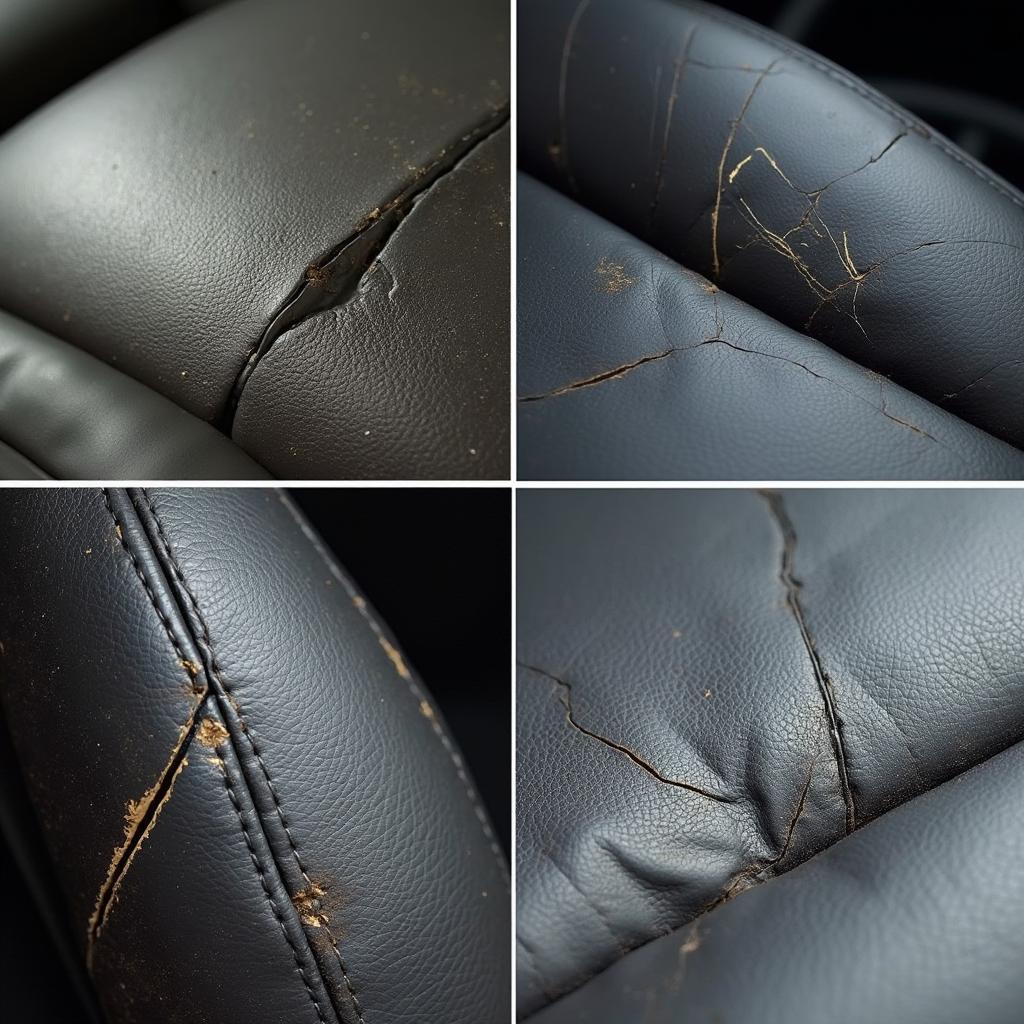Leather car seats are a luxurious addition to any vehicle, but they require special care to maintain their supple texture and opulent appearance. Over time, wear and tear can take a toll on leather seats, leading to cracks, fading, and unsightly blemishes. But before you consider costly reupholstering, you can absolutely revitalize your car’s interior with a few simple steps. This guide will cover everything you need to know about how to repair worn leather car seats, from identifying the type of damage to choosing the right repair products.
Assessing the Damage: Understanding the Enemy
Before you grab your tools, it’s crucial to identify the type of damage your leather seats have endured. This will determine the best course of action for repair. Common issues include:
- Cracks: These can range from tiny hairline fractures to larger splits, often caused by dryness, sun exposure, and regular wear.
- Scratches: Sharp objects, pet claws, or even rough clothing can leave unsightly marks on leather surfaces.
- Fading and Discoloration: Prolonged exposure to sunlight can cause the leather’s color to fade, while spills and stains can leave behind unsightly blemishes.
- Wear and Tear: High-traffic areas like the driver’s seat often experience thinning, smoothing, and loss of texture due to constant friction.
Gathering Your Arsenal: Essential Leather Repair Supplies
Once you’ve assessed the battlefield, it’s time to gather your weapons of choice. Here are the essential supplies you’ll need for most leather car seat repairs:
- Leather Cleaner: A specialized cleaner will remove dirt, grime, and grease without stripping the leather’s natural oils.
- Leather Conditioner: This crucial product replenishes moisture, keeping the leather supple and preventing further drying and cracking.
- Leather Repair Kit: For cracks, tears, and burns, a leather repair kit typically includes a color-matched filler, adhesive, and graining paper to mimic the leather’s texture.
- Soft Microfiber Cloths: These are ideal for applying cleaning and conditioning products, as well as buffing the leather to a shine.
- Rubbing Alcohol (Isopropyl Alcohol): Used for cleaning the leather surface and ensuring proper adhesion of repair products.
- Masking Tape: Protects surrounding areas when working with liquid leather fillers or dyes.
- Scissors: Useful for trimming patching material or graining paper.
The Art of Restoration: A Step-by-Step Guide to Repair
Now that you’re familiar with the enemy and have your supplies ready, let’s dive into the step-by-step process of repairing your worn leather car seats:
- Prepare the Battlefield: Thoroughly vacuum the seats to remove loose dirt and debris. Then, using a leather cleaner and a microfiber cloth, gently clean the entire surface, paying extra attention to areas with ingrained dirt.
- Target Practice (Cleaning): For stubborn stains or heavily soiled areas, apply a small amount of rubbing alcohol to a clean microfiber cloth and gently rub the affected area. Avoid excessive rubbing, as it can damage the leather.
- Repairing Minor Imperfections: For minor scratches and scuffs, a leather conditioner may be sufficient to mask the damage. Apply the conditioner to a clean microfiber cloth and gently work it into the leather using circular motions.
- Patching Up the Trenches (Cracks and Tears): For deeper cracks and tears, a leather repair kit is your best bet. Follow the manufacturer’s instructions carefully. In general, you’ll need to clean the area with alcohol, apply the leather filler, allow it to dry, and then use the graining paper to create a texture that matches the surrounding leather.
- Restoring Vibrance (Color Correction): If the leather is faded or discolored, a leather dye can restore its original color. Choose a dye that closely matches the leather’s original shade. Apply the dye in thin, even coats, allowing each coat to dry completely before applying the next.
- Preserving the Victory (Conditioning): Once the repairs are complete and the dye (if used) is dry, apply a high-quality leather conditioner to the entire seat. This will help keep the leather soft, supple, and protected from future damage.
Expert Insights: Tips from a Seasoned Car Repair Specialist
We consulted with Mike Johnson, a seasoned car repair specialist with over 20 years of experience, to gain valuable insights on leather car seat repair. Here’s what he had to say:
“Many car owners underestimate the importance of regular leather conditioning. Think of it like moisturizing your skin – it prevents dryness, cracking, and premature aging. A good rule of thumb is to condition your leather seats every three months, or more frequently if you live in a hot, dry climate.”
Mike also emphasized the importance of using high-quality, leather-specific products. “Avoid using harsh household cleaners or all-purpose protectants on your leather seats,” he cautions. “These products can strip the leather of its natural oils, leading to dryness and cracking.”
Frequently Asked Questions
Q: Can I use a hairdryer to speed up the drying time of leather repair products?
A: While it might seem tempting, it’s best to avoid using a hairdryer. Excessive heat can damage the leather and cause the repair products to dry unevenly.
Q: My leather seats are quite old and severely cracked. Is repair even an option?
A: For extensive damage, a professional reupholstery might be the most viable solution. However, you can try repairing smaller, isolated areas first to see if it improves the overall appearance.
Q: How often should I condition my leather car seats?
A: A good rule of thumb is to condition your seats every three months, but more frequent conditioning might be necessary if you live in a harsh climate or frequently expose your car to direct sunlight.
Need More Help?
Remember, maintaining the pristine condition of your car’s interior is an investment that pays off. If you’re unsure about any step of the repair process, or if the damage seems too extensive, it’s always best to consult a professional car upholstery specialist.
For personalized advice or assistance with complex car repairs, reach out to our team of experts. Contact us via WhatsApp at +1(641)206-8880 or email us at [email protected]. Our dedicated customer support team is available 24/7 to address your concerns and provide tailored solutions.



